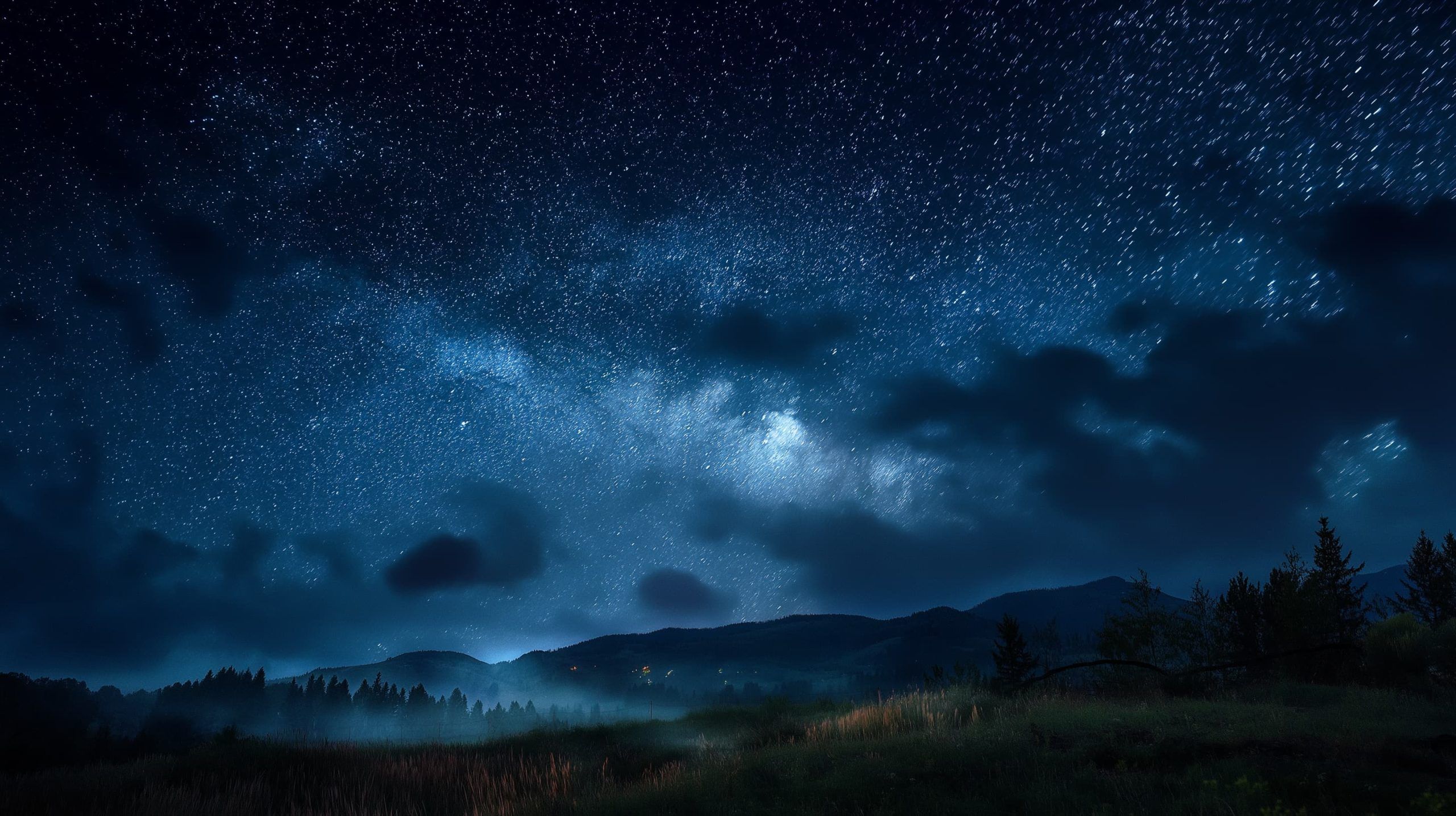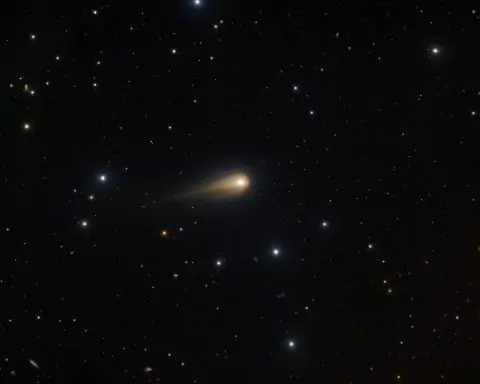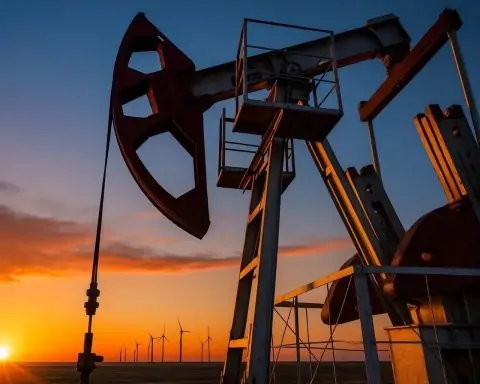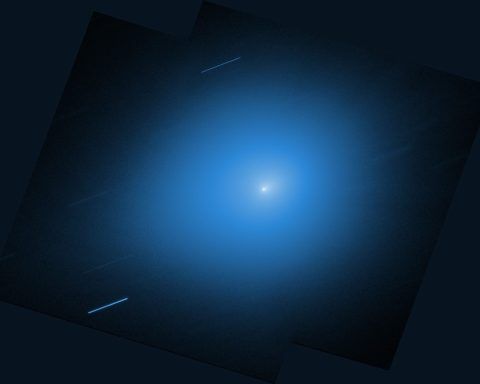- The Perseid Meteor Shower peaks on the night of August 11–12, 2025, under a waning gibbous Moon about 84% illuminated, with expected meteor rates of 10–20 per hour in bright conditions despite the usual 50–100 per hour under dark skies.
- Venus–Jupiter conjunction occurs August 11–12, 2025, with the two planets separated by about 0.5°–1°, Venus at magnitude −4 and Jupiter at magnitude −2, rising in the eastern pre-dawn sky around 4:30–5:00 a.m.
- Saturn rises around 10:30 p.m. in early August and by mid-August is up by about 8:30 p.m., shining in Aquarius with its rings visible in a small telescope.
- Mars is visible low in the western sky after sunset in August 2025 at about magnitude +1.8 and will set relatively quickly.
- Mercury is not readily visible on August 10–11 and will begin its morning apparition later in August.
- The Moon on August 10–11 is waning gibbous, around 90% to 80% illuminated, rising in mid-evening and brightening the sky, which can wash out faint meteors.
- A G2 (moderate) geomagnetic storm occurred around August 9 due to a CME from August 5, with a Kp index near 6, increasing the chance of auroras at high latitudes.
- The International Space Station will have visible passes after sunset or before sunrise on August 10–11, typically magnitudes −2 to −4 and lasting 4–6 minutes per pass, with Spot the Station providing timings.
- SpaceX launched a Falcon 9 Starlink mission on August 10 at 8:16 a.m. EDT from Cape Canaveral and a second mission for Amazon’s Project Kuiper was scheduled for August 11 at 5:35 a.m. PT from Vandenberg, with a third Starlink launch expected August 11 at 7:05 p.m. PDT.
- The ULA Vulcan Centaur rocket for USSF-106 is planned from Florida on August 12 at 8:15 p.m. EDT, and Europe’s Ariane 6 rocket is expected to debut from Kourou on August 12–13.
The nights of August 10–11, 2025 promise an exciting cosmic showcase. From a major meteor shower reaching peak activity, to planets performing a close dawn conjunction, to possible auroral glows and even rocket launch spectacles, there’s a bit of everything for skywatchers. Below we break down all the notable celestial events and how to see them, with expert tips on timing and viewing conditions across different regions.
In summary, here’s what to watch for on these dates:
- Perseid Meteor Shower – Annual meteor display peaking under the glare of a waning full moon (the “Sturgeon Moon”), with best viewing after midnight.
- Venus–Jupiter Conjunction – The two brightest planets appear extremely close together before sunrise on Aug 11–12, shining side by side in the eastern sky.
- Bright Moon & Observing Conditions – An 80–90% illuminated moon will brighten the night, so viewers should adjust expectations and use smart techniques (e.g. find moonshade, dark-sky sites).
- Visible Planets – Saturn and Mars also grace the night (Saturn rising by late evening; Mars low at dusk), while Venus and Jupiter dominate the pre-dawn.
- Aurora Alerts – A recent solar storm (G2-level) could spark northern lights sightings at high latitudes, so aurora hunters should stay vigilant [1] [2].
- ISS & Satellites – The International Space Station will make timely flybys (visible as a bright moving “star”), and recently launched satellites (like SpaceX Starlink) may show up as strings of lights.
- Rocket Launches – Space agencies and companies have launches slated around these nights, potentially creating brief sky spectacles (glowing rocket plumes at dawn/dusk) for those near launch sites [3].
- Space News & Upcoming Events – NASA and others have shared special commentary for these events, and more celestial happenings (like a total lunar eclipse in September [4] and other meteor showers) are on the horizon.
Below, we dive into each of these in detail, with guidance on when and where to look, expert quotes, and links to resources for further exploration.
Perseid Meteor Shower Peaks – Under a Moonlit Sky
Caption: A bright Perseid meteor streaks across the starry sky above Spruce Knob, West Virginia on August 3, 2025 [5]. The annual Perseids remain a highlight of August nights, although 2025’s display is softened by moonlight.
The Perseids – often called the year’s most popular meteor shower [6] – are reaching their peak on the night of August 11–12, 2025 (Tuesday night into early Wednesday). Typically, this shower produces a reliable abundance of “shooting stars” (under ideal dark skies, ~50–100 meteors per hour at peak) [7]. However, this year a waning gibbous Moon will share the sky, dramatically reducing the visible meteor counts. The moon was full (the Sturgeon Moon) on Aug 9 and will still be ~84% illuminated on the peak night [8] [9], drowning out fainter meteors.
“The average person under dark skies could see somewhere between 40 and 50 Perseids per hour,” says Bill Cooke, who leads NASA’s Meteoroid Environment Office. “Instead, you’re probably going to see 10 to 20 per hour or fewer, and that’s because we have a bright Moon in the sky washing out the fainter meteors.” [10]
In other words, expect quality over quantity – the brightest Perseid fireballs will still shine through the moonlight, even if the overall count is lower [11]. The Perseids are known for fast, colorful meteors with long streaks and occasional fireballs (exceptionally bright meteors) [12] [13]. Those dramatic ones “will have little problem shining through any moonlight,” as one skywatching guide noted [14]. But many of the faint Perseids will be washed out. In fact, the American Meteor Society estimates only about 25% of the usual meteors may be visible in 2025’s bright conditions – roughly 10–20 meteors per hour at best during the peak [15].
When & how to watch: The Perseids have been active since late July and continue through Aug 24, but highest rates occur in the predawn hours around Aug 11–13. Late night August 11 into the early hours of August 12 will be the prime window (and the night before, Aug 10–11, also offers decent activity). Plan to observe between midnight and dawn, when the shower’s radiant (in the constellation Perseus) climbs higher [16]. “You’re not going to see Perseids around suppertime… You’re going to have to go out later,” advises Cooke [17]. He notes the best hour is roughly 2–3 a.m. local time for most locations, when Earth’s rotation has you facing into the meteor stream [18].
No matter where you are, give your eyes ~30 minutes to adjust to the dark (you will catch more meteors once fully dark-adapted) [19]. Because the Moon will be bright and up all night, try to position yourself in a moon shadow – for example, on the north side of a building or hill that blocks the Moon, or under an object that keeps direct moonlight out of your eyes [20]. “Look anywhere but at the Moon,” as Cooke quips [21]. This will help you see more faint meteors. Also, get away from city lights if possible – a darker rural sky greatly multiplies the meteors you’ll see.
Where to look: The Perseids appear to radiate from the northeast part of the sky (near the constellation Perseus, which rises by late evening in the north-northeast) [22]. However, you don’t need to stare directly at the radiant – Perseid meteors will streak across all parts of the sky. A good strategy is to lie back and gaze about 45°–90° away from the radiant (so that meteors have longer trails) and opposite the Moon. For example, if the Moon is in the southern sky, face toward the darker northeast or northwest sky. Keeping the Moon at your back will improve your odds [23].
Northern vs Southern Hemisphere: The Perseids strongly favor the Northern Hemisphere. Northern observers have the radiant high in the sky before dawn and could see (in a dark year) dozens of meteors per hour. In 2025’s moonlit conditions, that might be pared down to ~10 meteors/hour for mid-northern latitudes (maybe a few more in ideal locations) [24]. In contrast, the Southern Hemisphere sees far fewer Perseids – the radiant never rises very high above the horizon for most southern latitudes. For example, the American Meteor Society notes that under comparable conditions, a Southern Hemisphere observer might see less than half the meteors a Northern observer would [25]. If you’re in, say, Australia or South Africa, you’ll need to look toward your northern horizon in the hours before dawn, and you may catch only a handful of Perseids at best. (If you’re far south of the equator, Perseus may barely peek above the horizon, making Perseid spotting quite difficult.)
Minor showers: Around the same period, a couple of minor meteor showers are also active – notably the Southern Delta Aquariids and Alpha Capricornids, which peaked in late July. These continue to contribute a few meteors per hour into mid-August [26] [27]. The Southern Delta Aquariids, which can produce faint meteors with persistent trails, are best seen from the Southern Hemisphere (their radiant in Aquarius lies in the far southern sky for the Northern Hemisphere) [28]. The Alpha Capricornids are known for slow, bright fireballs despite their low rates [29]. However, in 2025 the bright Moon will likely obscure most meteors from these minor showers [30]. You might randomly catch one or two (especially Capricornids, which are bright) intermingled with the Perseids, but the Perseids will dominate the show by sheer numbers.
Expert tip: “The best advice is to watch with your back to the moon,” says Live Science astronomy columnist Jamie Carter [31]. This way, you both avoid the moon’s glare and face the general direction of Perseus rising. Get comfortable – bring a reclining lawn chair or blanket so you can gaze upward without neck strain. Be patient; meteors come in spurts and lulls, so give yourself at least an hour of watching. Every shooting star you do catch is a little gift. As EarthSky notes, each Perseid you see is a bit of comet dust burning up ~60 miles above Earth – remnants of Comet Swift-Tuttle’s debris cloud that our planet plows through each year [32] [33]. Enjoy the experience, even if this year is more subdued. (And if the moonlight disappoints you, take heart: next year’s Perseids (August 2026) will peak under a new moon, so they should be truly spectacular [34]!)
Planets on Parade: Venus and Jupiter’s Dawn “Kiss”
While the meteors steal the late-night hours, the early morning of August 11 and 12 brings a planetary showstopper: Venus and Jupiter – the two brightest planets – will appear incredibly close together in the pre-dawn sky. In fact, they reach a near-conjunction on these dates, coming within about 0.5°–1° of each other (that’s just about a pinky-finger’s width at arm’s length!) [35]. This tight pairing of dazzling planets is a must-see even from cities.
When & where: Look east before sunrise. Venus and Jupiter will rise together out of the eastern horizon a couple of hours before the Sun. By about 4:30–5:00 a.m. local time (earlier or later depending on your latitude), you’ll spot an intense beacon of light – Venus – with Jupiter just nearby. Venus is currently a morning star, extremely bright (magnitude –4) and hard to miss. Jupiter appears fainter than Venus but is still one of the brightest objects in the sky (magnitude around –2). On August 11 and 12, they’ll be so close that they almost look like a double star in the dawn. “They appear at their closest on the 11th and 12th — only about a degree apart,” NASA confirms [36]. You might be able to see both planets in the same binocular field or even resolve Jupiter’s disk (and maybe a couple of its moons) alongside brilliant Venus through a telescope (exercise caution and stop observing before sunrise to avoid the Sun’s glare).
Caption: Diagram of the eastern pre-dawn sky on August 11–12, 2025, showing Venus and Jupiter extremely close (within ~1°) in the constellation Cancer [37]. This rare meet-up of the two brightest planets will be visible around the world just before sunrise. (Image credit: EarthSky.org)
Global visibility: This Venus-Jupiter conjunction is visible around the globe wherever the pre-dawn sky is dark. In the Northern Hemisphere, the planets will be a bit higher in the sky before sunrise, whereas observers in the Southern Hemisphere will see them slightly lower above the horizon – but in both cases, they should stand out clearly given their brilliance. As long as you have an unobstructed view of the east, you can enjoy this sight. Even city dwellers can see Venus and Jupiter despite light pollution (planets are bright!). Just make sure to look early enough – by 30–45 minutes before your local sunrise time, the sky will be getting too bright and Venus/Jupiter will start to fade into dawn light.
For reference, Venus will be about 20–30 degrees above the horizon by dawn (roughly one to two hand-spans at arm’s length) [38], and Jupiter will be right next to it, slightly lower. Mercury is also in the morning sky but much tougher to catch – it’s lower down and emerging from the Sun’s glare in mid-August, likely invisible around Aug 10–11 for most. Saturn, on the other hand, is a late-night planet now (more on Saturn below), and Mars is disappearing in the evening twilight.
Interesting facts: Venus and Jupiter conjunctions happen periodically (usually about once a year somewhere in the sky), but this close an approach is a treat. At <1° separation, Venus and Jupiter will almost seem to touch. If you hold up your thumb at arm’s length, you can cover both planets at once. These two worlds are actually hundreds of millions of miles apart in space, but from our Earthly perspective on these dates they line up almost along the same line of sight. The next mornings (Aug 13 onward), they’ll start to drift apart again. And mark your calendar: on Aug 19–20, the crescent Moon will join Venus and Jupiter in the dawn sky, creating a lovely trio [39] (that’s after our Aug 10–11 window, but worth noting).
So if you’re up hunting Perseids until the pre-dawn hours, don’t forget to turn your gaze toward Venus and Jupiter rising together – it’s like the “grand finale” of the night. As EarthSky put it, during the Perseids’ peak mornings, brilliant Venus and bright Jupiter make a dynamic duo in the east before sunrise, creating a spectacular scene [40].
Other Planets & Stars Visible Now
Beyond Venus and Jupiter’s close pairing, August 2025 offers great planetary viewing in general:
- Saturn – The ringed planet is reaching opposition later in the month, so it’s big and bright. In early August, Saturn rises around 10:30 p.m. local time, and by mid-August it’s rising by ~8:30 p.m. [41]. This means on Aug 10–11 nights, Saturn will be up by late evening and visible all night. Look for it in the southeastern sky by midnight and high in the south by early morning [42]. It shines with a steady yellowish light (in the constellation Aquarius, near the faint stars of Capricornus). Even a small telescope will reveal Saturn’s famous rings. Fun fact: in the predawn hours, Saturn will be in the west as Venus and Jupiter are in the east – you might see Venus, Jupiter, the Moon, and Saturn all at once spanning the sky.
- Mars – Mars is now a much subtler object than a year ago (when it was at opposition). In August 2025, Mars is a modest reddish “star” visible low in the western sky for about an hour after sunset [43]. It’s not very bright (about magnitude +1.8, similar to some Big Dipper stars [44]) and will set quickly. If you want to spot Mars on Aug 10 or 11, look west shortly after dusk – you’ll need a clear horizon and perhaps binoculars. Mars will soon disappear behind the Sun’s glare for a couple of months.
- Mercury – Mercury isn’t prominently visible on these specific nights. It will enter its morning apparition in late August [45], but around the 10th–11th it’s still too close to the Sun to see. Toward the end of August, sharp-eyed observers might catch Mercury very low in the east during dawn.
- The Moon – As mentioned, we’re just past the full Sturgeon Moon (full on Aug 9). On Aug 10–11 the Moon is a waning gibbous (~90% to 80% lit) rising in mid-evening and glowing all night. It will be positioned in the southern sky for most of the night (moving from southeast to southwest as the night progresses). While it hinders meteor observing, the moon itself is a splendid sight if you turn a telescope or binoculars on it – the bright moonlight brings out details on the lunar surface (though nearly full Moon means contrasts are a bit washed out). Moonset is after sunrise, so the Moon will be present until dawn. For those interested in the moon phase cycle: the Moon will continue waning in the following days, reaching last quarter on Aug 16 and new Moon on Aug 23 [46].
- Stars & constellations – Despite the moonlight, many bright stars and patterns can still be enjoyed. The Summer Triangle (stars Vega, Deneb, Altair) is almost directly overhead in mid-northern latitudes during late evening. Scorpius with reddish Antares is in the southwest. The Milky Way is normally a gorgeous band through Cygnus and Sagittarius on August nights; under the moon’s glare it will be subdued, but in very clear, dark areas you might still trace it. If you’re in a dark location after moonrise, you can try looking opposite the Moon (in the north) to glimpse the Milky Way’s faint glow. The moonlight will hide most faint stars, but the brightest ones like Arcturus (setting in west), Altair (overhead), Vega, Deneb, Antares, Fomalhaut (rising late in southeast) will still be visible. Interestingly, August is a great time for the “Summer Triangle” deep-sky objects if you have a telescope – for instance, M27 the Dumbbell Nebula in Vulpecula is high overhead all month [47]. But you’ll want to wait until the Moon is out of the sky (later in the month) for best views of faint nebulas and galaxies.
Auroras Possible: Solar Storm Watch and Geomagnetic Activity
Skywatchers at high latitudes (Canada, Northern U.S., Northern Europe, etc.) have an extra reason to keep an eye on the night sky: there’s a chance for aurora borealis displays around this time due to recent solar activity. In early August 2025, the Sun unleashed a coronal mass ejection (CME) from an active sunspot region on Aug 5 [48] [49]. This prompted NOAA’s Space Weather Prediction Center (SWPC) to issue a geomagnetic storm watch for August 8–9, expecting the CME to deliver a glancing blow to Earth’s magnetic field [50].
As of August 9, these predictions proved true: a G2 (Moderate) geomagnetic storm was observed that day, with NOAA confirming G2-level conditions (Kp index ~6) around 15:48 UTC on Aug 9 [51]. This means the Earth’s magnetic field was disturbed enough to produce auroras potentially visible much farther south than usual. During G2 storms, auroras can dip into the northern continental United States and Europe – roughly as far south as ~50° geomagnetic latitude (for reference, cities like Seattle, Chicago, Boston, Dublin, Hamburg are around that latitude). In fact, experts said auroras “may be visible from New York to Idaho” under the Aug 8–9 storm watch [52], and possibly in other countries at similar latitudes. Some early reports (if any from Aug 8–9) might show auroras photographed in places that rarely see them.
For the nights of Aug 10–11, the peak of that particular solar storm is likely waning. However, residual geomagnetic unrest could still spark auroras in high latitudes if the Earth’s magnetic field remains agitated. Skywatchers in Scandinavia, Scotland, Canada, Alaska, the northern continental US, and New Zealand/Tasmania (for aurora australis) should remain alert. It’s worth checking real-time aurora forecasts on the night. If you’re in a favorable location (far-north or far-south), peek to the north (or south, in the southern hemisphere) after local midnight: you might notice a faint greenish glow or pillars near the horizon if auroral activity persists. Keep in mind the bright Moon will also interfere by lighting up the sky, so auroras will have to be reasonably strong to be visible.
Current forecasts as of Aug 10 indicate the storm was moderate (NOAA G2) at its peak [53]. NOAA’s latest update suggested conditions would ease after Aug 9, but minor storming (G1) could continue intermittently [54] [55]. Another factor is that Earth is near the peak of Solar Cycle 25 – the Sun is quite active in 2025 – so even if one storm subsides, new solar flares or CMEs could happen with little warning. Always stay tuned to space weather alerts if you’re chasing auroras.
Aurora viewing tips: You need clear, dark skies with a good view to the north (or south). Get away from city lights and give your eyes time to adapt. Often, a camera will pick up auroras (as green or red tinges) before they are obvious to the naked eye. If the Kp index (geomagnetic index) is around 5 or 6, auroras might be visible in the northern U.S./Europe; if it reaches 7+, they can come farther south (Kp 7–8 auroras have in the past reached as far as e.g. southern UK, Germany, or states like Illinois). For the Aug 8–9 event, NOAA predicted a peak around Kp 6 with a secondary phase at Kp 5 [56]. In practical terms, that meant auroras were possible in ~15–18 U.S. states on the night of Aug 8–9 [57] [58] (and similarly across southern Canada and northern Europe). By Aug 10–11, we anticipate lower activity, but a mild auroral glow could still be present in places like northern Canada or over the Arctic.
If you’re in the right location, check the NOAA aurora oval forecast maps or apps on these nights. The NOAA Space Weather Prediction Center (SWPC) provides an Aurora Dashboard with real-time updates [59], and services like SpaceWeatherLive or the Aurora Forecast apps can alert you if geomagnetic activity spikes. Even a G1 minor storm can create beautiful auroras for high-latitude areas, so it’s worth a look. And if nothing else, you might enjoy the stars – as the old aurora-chaser saying goes, “Heads up, eyes north!”
(Side note: If you want to experience the Southern Hemisphere’s auroras (Aurora Australis), watch for similar alerts. The same solar storm could ignite auroras visible in southern Australia, New Zealand, or Antarctica. However, most of the media attention is on the northern lights simply due to population distribution.)
The International Space Station & Satellite Flybys
Not all “sky phenomena” are natural – some are human-made but still thrilling to spot. The International Space Station (ISS) is one such gem. Circling ~420 km above Earth, the ISS orbits the planet 16 times a day, and if you time it right, it looks like a brilliant, steady-moving star sliding across the dawn or dusk sky. During August 10–11, the ISS will have visible passes over many parts of the world in the hours after sunset or before sunrise (exact timings depend on your location).
For example, around these dates the ISS has a series of evening passes over the eastern United States and Canada (one news outlet noted a bright flyover was expected for millions on a recent Thursday night) [60]. In general, all sightings occur near dusk or dawn, when the station is sunlit against a dark sky [61]. You won’t see the ISS at midnight because Earth’s shadow will be covering it then. But within a couple hours after sunset or before sunrise, it can appear.
What to look for: The ISS typically appears as a fast-moving, non-blinking light traveling in a straight line across the sky. It can rival Jupiter or Venus in brightness, often reaching magnitude –2 to –4 (very bright). “The space station appears similar to an airplane or a very bright star moving across the night sky, except it does not have flashing lights or change direction,” NASA explains [62]. It usually takes about 4 to 6 minutes to cross the sky. The color is usually white or yellowish. If you see a steady light gliding from west to east (often southwest to northeast or another trajectory depending on the pass) in the early evening or predawn, it’s likely the ISS.
Each location has specific timings when the ISS is visible. You can find these by using NASA’s “Spot the Station” web tool or mobile app [63] [64], or websites like Heavens-Above. As an example, in London the ISS might be visible on Aug 10 at around 4:30 am for a few minutes low in the south; in New York, perhaps an evening pass around 9:00 pm is on the schedule; in Sydney, maybe a predawn pass, etc. It varies, so check your local predictions. (NASA recently shifted to relying on the mobile app for ISS sightings, but many third-party sites still provide schedules [65] [66].)
Besides the ISS, satellites and space debris are everywhere overhead. A fun one to watch for is the chain of Starlink satellites shortly after a launch. SpaceX launched a batch of Starlink internet satellites on Aug 10 (8:16 a.m. EDT from Florida) [67], and another launch is planned Aug 11–12. Often, a day or two after launch, people report seeing a “string of pearls” – a line of bright dots crossing the twilight sky. If you’re lucky, you might catch these Starlink trains (they dim as they disperse, but right after launch they can be quite visible). There’s even a website (FindStarlink) where you can check if any are expected to pass over your area.
Another satellite phenomenon is Iridium flares, but note: the classic Iridium satellites that caused spectacular flares have mostly been deorbited in recent years. Still, occasionally other satellites can flash if their solar panels catch the sunlight just right. For instance, the new BlueWalker 3 satellite (launched in 2022) can appear extremely bright at times.
Tips for satellite spotting: Like the ISS, satellites are best seen near dawn or dusk when they’re sunlit but you’re in darkness. If you see a faint moving star, it’s likely a satellite. If it flares into a bright flash and then disappears, that was likely a reflection off a satellite panel (a flare). With so many objects in orbit, you are guaranteed to see a few satellites in an hour of skywatching on any clear night, especially if away from city lights.
Rocket Launches Lighting Up the Sky
Rocket launches can create short-lived but extraordinary sky shows – glowing trails, comet-like plumes, and even weird phenomena like spirals or colorful clouds if conditions are right. Around August 10–11, 2025, there are a few launches to be aware of:
- SpaceX Falcon 9 – Starlink mission: On the morning of Aug 10 (8:16 a.m. EDT), SpaceX launched a Falcon 9 from Cape Canaveral, Florida, carrying a batch of Starlink satellites [68]. While this was after sunrise in Florida, observers further north along the Atlantic coast might have glimpsed the rocket’s contrail in the morning sky shortly after launch. Pre-sunrise or post-sunset rocket launches can produce spectacular glowing plumes as high-altitude exhaust catches sunlight – a phenomenon often dubbed the “space jellyfish.” Although this particular launch was in daylight, keep an eye on upcoming ones.
- SpaceX Falcon 9 – Project Kuiper: Another Falcon 9 was scheduled for Aug 11 (predawn, ~5:35 a.m. Pacific Time) from Vandenberg Space Force Base in California, to loft Amazon’s Project Kuiper satellites (KF-02 mission) [69]. If it occurred on time, West Coast early risers may have seen a bright ascending light and possibly a fan-shaped glow as the rocket headed to orbit. Launches from Vandenberg heading south often create visible phenomena across California’s dawn sky – there might even be reports of a mysterious “cloud” in the sky just before dawn from this launch.
- Other SpaceX Launches: SpaceX had a busy schedule – another Starlink launch was slated for Aug 11 evening (7:05 p.m. PDT) from California as well [70]. If that occurred at dusk, it might have made a brief appearance as a fiery streak for those in Southern California or neighboring states, shortly after sunset.
- Upcoming on Aug 12: Just beyond our window, on Aug 12 there’s an anticipated ULA Vulcan Centaur rocket launch (USSF-106 mission) from Florida at 8:15 p.m. EDT [71]. That one, if it happens on schedule, would be a night launch visible across the southeastern U.S. – something to watch tomorrow. And also around Aug 12/13, Europe’s new Ariane 6 rocket is expected to debut from Kourou, French Guiana [72]. While not visible to most of us, it’s a noteworthy spaceflight milestone (and folks in Guiana or neighboring areas might see it).
Caption: Time-lapse of a Falcon 9 rocket launch, creating a glowing arc as it carries satellites to orbit. Around Aug 10–11, multiple launches (SpaceX Starlink and Amazon’s Kuiper) were scheduled, which could produce similar streaks or “jellyfish” plumes in the sky for lucky observers near the launch sites [73]. (Image credit: SpaceX / Space.com)
Viewing a launch: If you live near a launch site (e.g. Florida’s Space Coast, coastal California for Vandenberg launches, etc.), definitely see if any public viewing or simply outdoor watching is possible. Even from hundreds of miles away, a night or dawn launch can be visible: for instance, people in Los Angeles often see Vandenberg launches as a bright light in the northwest. On the U.S. East Coast, launches from Cape Canaveral can sometimes be spotted as far as Georgia or even the Carolinas along the horizon. The key is a clear view and knowing when/where to look.
For those not near any rocket launch, you can always catch them via live webcasts (SpaceX streams all its launches, for example). But since this report is about sky phenomena, it’s worth noting how rocket launches have become a part of the skywatching landscape – especially with companies like SpaceX launching frequently. In fact, 2025 has been an exceptionally busy launch year (SpaceX’s 100th mission of the year was the Aug 9 Kuiper launch) [74], meaning the odds of seeing a rocket in flight have gone up.
One caution: sometimes people confuse a rocket’s trajectory for something like a UFO or weird atmospheric event (the “spiral” sightings, for example, often turn out to be fuel venting from a rocket stage, creating a spiral cloud). So if you see something odd in the sky, it could just be Elon Musk or Jeff Bezos sending up another payload!
Space Agency & Observatory Highlights
Around these dates, space agencies and observatories have been actively sharing information and hosting events related to the sky:
- NASA’s Guidance and Live Streams: NASA’s Marshall Space Flight Center issued a special blog advisory about the Perseids’ peak being affected by moonlight [75], including expert quotes (like Bill Cooke’s above) and tips for observers. NASA’s “What’s Up” August 2025 video and article also highlighted the Venus-Jupiter conjunction and the Perseids, preparing skywatchers for what to expect [76] [77]. While NASA isn’t hosting a formal Perseid webcast this year (some years they do when conditions are perfect), you can follow NASA Meteor Watch on social media for updates. In fact, NASA’s meteor scientists are operating all-sky cameras; one composite image from Huntsville on Aug 7 captured over 20 Perseid meteors in one night [78] – showing that despite the moon, the shower is underway.
- International Space Station News: NASA also had big news on Aug 8–9 with the return of the Crew-10 astronauts from the ISS [79] [80]. While not exactly a skywatching event, it’s interesting context: four crew members rode a Dragon capsule back to Earth, splashing down off Florida on Aug 9. If you lived along the reentry path at night, you might even have seen the plasma trail of the capsule – basically a man-made “meteor”! (Reentries can appear as bright streaks too.)
- ESA & Other Missions: The European Space Agency’s JUICE spacecraft (headed to Jupiter’s moons) is performing a Venus flyby in August 2025 [81]. This isn’t visible, but it’s a crucial mission milestone happening behind the scenes on Aug 18. ESA might release updates or images if available, so space enthusiasts can watch for that news. Also, ESA’s new Ariane 6 rocket debut (mentioned above) is a major event in the spaceflight community – after many delays, seeing it launch (even via live stream) on Aug 12/13 will be exciting.
- Observatory Events: Many local planetariums, science centers, and astronomy clubs are seizing the opportunity to host public events. For instance, some observatories plan Perseid meteor shower viewing nights (even with the moon, it’s an annual tradition). These often involve expert talks, telescopes pointed at planets, etc. Check your local area – e.g., in the U.S., places like Griffith Observatory in LA or Adler Planetarium in Chicago often give skywatching guidance. In the U.K., Royal Observatory Greenwich and others put out sky reports (August’s focus being the Perseids and planets). And if you’re in a remote area, consider joining any star party or just gather some friends for a night under the (moonlit) stars.
- Scientific Announcements: Early August saw a flurry of space science news – NASA’s Hubble and Webb telescopes made headlines with new images/discoveries (like Hubble’s photo of the Tarantula Nebula [82] and Webb finding evidence of a planet around a nearby sun-like star [83]). While these aren’t things you can see in the sky with your eyes, they add to the general excitement about astronomy this month. Sometimes during meteor showers, scientists also discuss comet research (since the Perseids’ parent comet Swift-Tuttle is well studied). There’s ongoing research into meteor compositions via spectroscopy; you might hear tidbits in the news about what Perseids teach us.
Lastly, note that another meteor shower – the Orionids – and an annular solar eclipse – are coming up in October 2025, and a long total lunar eclipse on Sept 7, 2025 (visible across Australia/Asia/Africa/Europe) is on the calendar [84]. So the skywatching fun doesn’t stop with August 11! Keep looking up, as there’s always something on the horizon.
Viewing Conditions & Tips Recap
To maximize your skywatching on Aug 10–11, here’s a recap of practical tips:
- Check the weather forecast for your area. Even the greatest celestial event means nothing if clouds block the view. If storms or clouds are predicted, you might consider a short drive to a clearer area if feasible. As a general trend, August often has patchy clouds; this year forecasters noted that around the Perseid peak, western North America and parts of the U.S. East Coast had favorable clear skies, whereas more clouds were expected in the Midwest and Southeast [85]. Wildfire smoke can also introduce haze, especially in northern regions [86] – something to consider since it can dim the view of faint meteors or auroras.
- Dark adaptation: Give yourself plenty of time under the night sky without looking at any phones or bright lights. This will improve your ability to catch faint meteors and the subtle auroral glow if present.
- Equipment: None required for meteors or conjunctions – your eyes are best. A reclining chair or blanket, warm clothing (or bug spray in mosquito-prone areas!), and snacks/drinks will keep you comfortable. If you have binoculars, you can enjoy views of Jupiter’s moons or craters on the Moon, but put them down when watching for meteors (meteors are best seen with wide vision).
- Photography: If you’re into astrophotography, you can attempt to capture meteors by using a camera on a tripod with long exposures (high ISO, 20-30 second shots, continuous). Include some landscape for context. For planets, use shorter exposures (Venus is bright enough to affect camera sensors strongly). And for auroras, wide-angle long exposures (high ISO, a few seconds) will reveal colors your eyes might not see.
- Safety: If you venture out late at night to a dark site, go with a buddy or let someone know. Take a flashlight (with red filter ideally) for navigation. Be mindful of wildlife or other people in remote areas.
- Enjoy the moment: Yes, fewer Perseids will be visible this year, but the ones you do see will be memorable – especially if you catch a fireball splitting the sky. The conjunction of Venus and Jupiter is a reminder of the clockwork majesty of the solar system, playing out above the morning commute. Even the bright Moon can be appreciated – after all, it’s our nearest celestial neighbor and it’s only because of its reflected sunlight that our night isn’t completely dark this time. So, take a moment to look at Luna’s landscape too (with binoculars you can see the Mare and some large craters).
By following these tips, you’ll make the best of the Aug 10–11 sky spectacles.
Further Resources for Skywatchers
For those who want to dive deeper or get real-time updates on these events, here are some excellent resources:
- NASA Meteor Shower Portal – An interactive tool to monitor meteor activity in real time [87]. You can see live meteor counts and radiant maps from NASA’s camera networks. (Website: meteorshowers.seti.org)
- International Meteor Organization (IMO) Live Updates – The IMO provides a live meteor rates graph during major showers and reports from observers worldwide.
- NOAA Space Weather Prediction Center (SWPC) – Check out SWPC’s Aurora Dashboard for tonight’s aurora visibility map (Northern and Southern Hemisphere) and the 3-day geomagnetic forecast [88]. They also post alerts when storm watches are issued (e.g., the G1/G2 watch for Aug 8–9).
- Aurora Alerts Apps – Apps like Aurora Forecast, My Aurora Forecast & Alerts, or SpaceWeatherLive can send notifications if geomagnetic conditions might yield auroras at your location [89].
- NASA “Spot the Station” – Download NASA’s Spot The Station app or visit their website to get ISS flyover times for your city [90] [91]. The app can notify you before an ISS pass.
- Heavens-Above.com – A great website for satellite spotting, including ISS, Starlink passes, rocket bodies, etc. Just input your location.
- Space Launch Schedule – For rocket launch fans, you can find schedules on sites like Spaceflight Now or Space.com’s Space Calendar [92], which lists upcoming launches and sky events.
- Local Astronomy Clubs – Find an astronomy club or observatory near you. They often host public nights around meteor showers and can offer expert guidance. The Astronomical League (for the U.S.) or equivalent organizations in other countries have directories of clubs.
- Live Streams – If you’re clouded out or prefer indoors, you can watch events like the Perseids via live broadcasts. For instance, the Virtual Telescope Project in Italy often streams meteor showers, and NASA might stream the aurora from the ISS if crew are capturing it (sometimes happens).
- Sky at Night Magazine / EarthSky / Space.com – These publications provide excellent monthly sky guides and often have detailed articles on how to watch events. For example, EarthSky’s article on the Perseids 2025 gives additional context [93] [94], and Space.com had a piece noting the Perseids this year might be “about quality, not quantity” due to the Moon [95].
Keep these resources handy, and you’ll be well-prepared not just for Aug 10–11, 2025, but for all your upcoming skywatching adventures. Clear skies, and happy gazing! Here’s wishing you dark skies and plenty of cosmic delights this week – whether it’s a wish upon a Perseid meteor, a glimpse of Venus and Jupiter’s celestial rendezvous, or maybe a surprise aurora dancing on your horizon.
Sources: The information above is compiled from expert sources including NASA [96] [97], the American Meteor Society [98], NOAA’s Space Weather Center [99], astronomy news outlets (Space.com [100] [101], Live Science [102] [103], EarthSky [104]), and the Washington Post’s Capital Weather Gang for regional sky conditions [105] [106]. These provide validated details on timing, visibility, and expected performance of each phenomenon. For further reading or real-time updates, see the links in the Further Resources section above, and enjoy the show!
References
1. www.livescience.com, 2. www.livescience.com, 3. www.space.com, 4. www.space.com, 5. www.nasa.gov, 6. www.washingtonpost.com, 7. www.washingtonpost.com, 8. science.nasa.gov, 9. www.washingtonpost.com, 10. www.nasa.gov, 11. www.washingtonpost.com, 12. www.washingtonpost.com, 13. www.washingtonpost.com, 14. www.washingtonpost.com, 15. earthsky.org, 16. www.nasa.gov, 17. www.nasa.gov, 18. www.nasa.gov, 19. www.washingtonpost.com, 20. www.washingtonpost.com, 21. www.nasa.gov, 22. www.livescience.com, 23. www.livescience.com, 24. www.nasa.gov, 25. www.amsmeteors.org, 26. www.livescience.com, 27. www.livescience.com, 28. www.livescience.com, 29. www.livescience.com, 30. www.washingtonpost.com, 31. www.livescience.com, 32. earthsky.org, 33. earthsky.org, 34. www.washingtonpost.com, 35. earthsky.org, 36. science.nasa.gov, 37. earthsky.org, 38. science.nasa.gov, 39. science.nasa.gov, 40. earthsky.org, 41. science.nasa.gov, 42. science.nasa.gov, 43. science.nasa.gov, 44. science.nasa.gov, 45. science.nasa.gov, 46. www.washingtonpost.com, 47. science.nasa.gov, 48. www.space.com, 49. www.livescience.com, 50. www.livescience.com, 51. www.spaceweather.gov, 52. www.livescience.com, 53. www.livescience.com, 54. www.space.com, 55. www.space.com, 56. www.space.com, 57. www.space.com, 58. www.space.com, 59. www.livescience.com, 60. www.newsweek.com, 61. www.nasa.gov, 62. www.nasa.gov, 63. www.nasa.gov, 64. www.nasa.gov, 65. nasawatch.com, 66. hackaday.com, 67. www.space.com, 68. www.space.com, 69. nextspaceflight.com, 70. nextspaceflight.com, 71. www.space.com, 72. www.space.com, 73. www.space.com, 74. www.space.com, 75. www.nasa.gov, 76. science.nasa.gov, 77. science.nasa.gov, 78. www.nasa.gov, 79. www.space.com, 80. www.space.com, 81. www.space.com, 82. science.nasa.gov, 83. science.nasa.gov, 84. www.space.com, 85. www.washingtonpost.com, 86. www.washingtonpost.com, 87. www.amsmeteors.org, 88. www.livescience.com, 89. www.space.com, 90. www.nasa.gov, 91. www.nasa.gov, 92. www.space.com, 93. earthsky.org, 94. earthsky.org, 95. www.washingtonpost.com, 96. www.nasa.gov, 97. www.nasa.gov, 98. earthsky.org, 99. www.livescience.com, 100. www.space.com, 101. www.space.com, 102. www.livescience.com, 103. www.livescience.com, 104. earthsky.org, 105. www.washingtonpost.com, 106. www.washingtonpost.com









